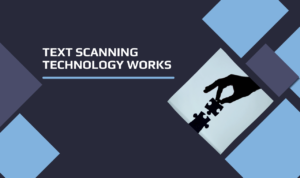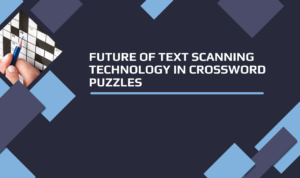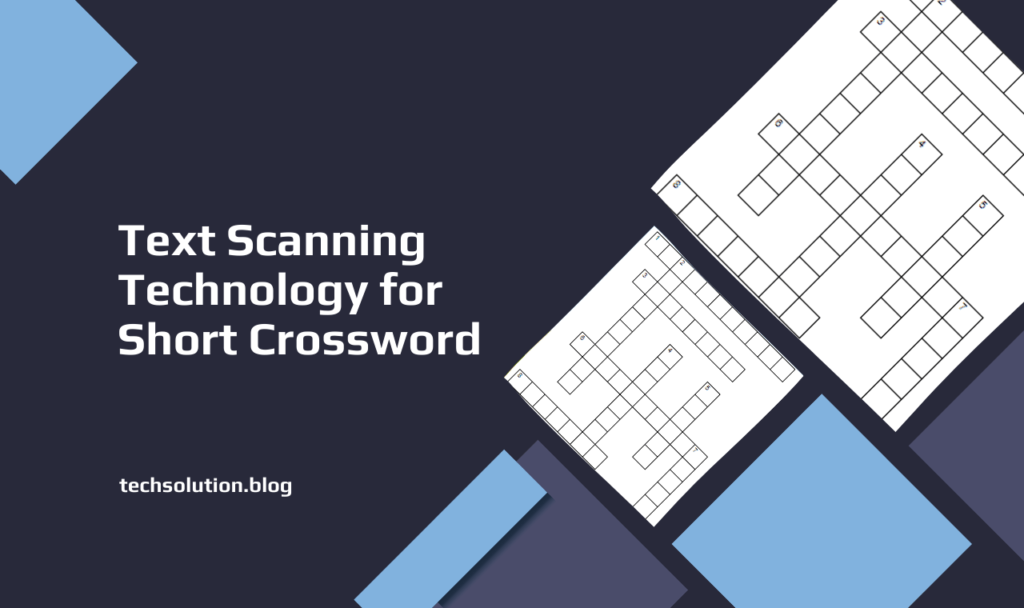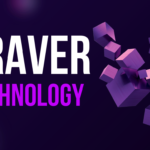Crossword puzzles are no longer just a battle of wits—they’re a blend of strategy and technology. Every day, over 50 million people across the globe tackle a crossword puzzle, striving to crack those cryptic clues. Yet, even seasoned solvers can feel stuck staring at a grid that seems to mock their efforts. Enter text scanning technology. This game-changing innovation is rewriting the rules of crossword-solving, making the process faster, smarter, and surprisingly effortless.
Imagine pointing your phone at a puzzle and having it highlight potential answers in seconds. That’s not a futuristic fantasy—it’s happening now. Text scanning tools analyze crossword grids, identify patterns, and offer hints that streamline the solving experience. Whether you’re a casual puzzler or a crossword pro, this technology can transform frustration into fun.
Let’s dive into how it works, why it’s so effective, and how you can use it to ace your next crossword. Ready to revolutionize your puzzle-solving game? Let’s get started!
The Rise of Text Scanning Technology in Crossword Puzzles
Text scanning technology is not a new concept; it plays a role in various fields such as document processing, optical character recognition (OCR), and translation services. However, its application in the realm of crossword puzzles, particularly short crosswords, is a more recent development. This technology leverages advanced algorithms and machine learning to analyze and understand text, making it easier for solvers to find the correct answers quickly and accurately.
This technology is especially beneficial for short crossword puzzles, where word lengths are typically limited to three to five letters. These puzzles often rely on concise clues that can be ambiguous or require a deep understanding of the context. By scanning the clues and cross-referencing them with a vast database of words and phrases, text scanning technology can suggest possible answers, saving solvers time and reducing frustration.
How Text Scanning Technology Works

At its core, text scanning technology for short crossword puzzles works by analyzing the clues provided in the puzzle and comparing them against a large corpus of language data.
This process involves several key steps:
- Clue Recognition: The technology first scans the crossword puzzle to identify and recognize the clues. This can be done through OCR if the puzzle is in a printed format or by directly analyzing digital text.
- Contextual Analysis: After recognizing the clues, the technology performs a contextual analysis to understand their meaning. This involves breaking down the clues into their semantic components and determining the most likely interpretation based on context.
- Cross-Referencing: The technology then cross-references the analyzed clues with a database of potential answers. This database draws from a variety of sources, including dictionaries, thesauruses, and past crossword puzzles, ensuring a comprehensive range of possible solutions.
- Answer Suggestion: Finally, the technology suggests potential answers that fit the length and structure of the crossword grid. The system ranks these suggestions based on their likelihood of being correct, enabling solvers to choose the most appropriate answer.
This entire process occurs in a matter of seconds, providing solvers with almost instant feedback and guidance. You can integrate the technology into various platforms, such as crossword apps, online puzzle sites, or standalone software, making it accessible to a wide range of users.
The Benefits of Text Scanning Technology for Puzzle Solvers
The introduction of text scanning technology has brought numerous benefits to crossword enthusiasts, particularly those who enjoy short crossword puzzles.
Here are some of the key advantages:
- Increased Accessibility: One of the most significant benefits of text scanning technology is that it makes crossword puzzles more accessible to a broader audience. Even those who are new to puzzles or struggle with certain clues can now enjoy the satisfaction of solving a crossword with a little assistance.
- Enhanced Learning: For those looking to improve their vocabulary and language skills, text scanning technology can serve as an educational tool. By suggesting answers and providing explanations for clues, the technology helps solvers learn new words and phrases, reinforcing their understanding of language.
- Time Efficiency: Solving a crossword puzzle can be time-consuming, especially when you’re stuck on a difficult clue. Text scanning technology streamlines the process by quickly providing possible answers, allowing solvers to complete puzzles faster and move on to new challenges.
- Reduced Frustration: Nothing is more frustrating than being stuck on a single clue that prevents you from finishing a puzzle. With text scanning technology, solvers can overcome these roadblocks with ease, reducing frustration and enhancing the overall enjoyment of the puzzle.
- Customization and Personalization: Many text scanning tools offer customization options, allowing solvers to adjust the difficulty level or receive hints based on their preferences. This personalization makes the crossword-solving experience more tailored to individual skill levels and interests.
Broader Implications of Text Scanning Technology in Word Games
While text scanning technology is making a significant impact on short crossword puzzles, its applications extend beyond just crosswords. This technology has the potential to revolutionize the entire landscape of word games, offering new ways to engage with language and puzzles.
- Integration with Other Word Games: You can apply text scanning technology to various word games, such as word searches, anagrams, and Scrabble. By analyzing and suggesting words, the technology can enhance the gameplay experience, making these games more enjoyable and accessible to a wider audience.
- Educational Applications: Beyond entertainment, text scanning technology has valuable educational applications. Teachers and educators can use this technology to create interactive and engaging language learning activities. For example, students can use text scanning tools to receive hints while solving puzzles, helping them learn new vocabulary in a fun and interactive way.
- Cross-Platform Accessibility: With the rise of mobile apps and online platforms, text scanning technology can be integrated across various devices, ensuring that users can access it wherever they are. Whether you’re solving a puzzle on your smartphone, tablet, or computer, the technology provides consistent support and guidance.
- AI-Powered Puzzle Creation: In addition to helping solvers, text scanning technology can also be used by puzzle creators to generate new puzzles. By analyzing existing puzzles and identifying patterns, the technology can suggest new clues and answers, making it easier for creators to design engaging and challenging puzzles.
- Enhanced Puzzle Analysis: For avid crossword enthusiasts, text scanning technology offers a new way to analyze and understand puzzles. By breaking down clues and answers, the technology can provide insights into common patterns, word usage, and puzzle design, helping solvers improve their skills and develop a deeper appreciation for the art of crossword construction.
The Future of Text Scanning Technology in Crossword Puzzles

As technology continues to advance, the capabilities of text scanning technology are likely to expand even further. Here are some potential developments we may see in the future:
- Real-Time Collaboration: Imagine solving a crossword puzzle with a friend or a group of people in real-time, with text scanning technology providing instant feedback and suggestions. This collaborative approach could bring a social element to crossword puzzles, making them a shared experience rather than a solitary activity.
- Voice-Activated Assistance: With the rise of voice recognition technology, we may soon see text scanning tools that can be operated through voice commands. Solvers could simply speak a clue aloud and receive suggestions without needing to type or click, making the experience even more seamless and user-friendly.
- Advanced Language Understanding: As artificial intelligence and natural language processing technologies continue to evolve, text scanning tools will become even more sophisticated in understanding complex clues and language nuances. This will result in more accurate and contextually relevant suggestions, further enhancing the puzzle-solving experience.
- Integration with Augmented Reality (AR): In the future, we may see text scanning technology integrated with augmented reality devices. Solvers could point their AR glasses or smartphone camera at a printed crossword puzzle, and the technology would overlay suggestions and hints directly onto the puzzle, creating an immersive and interactive experience.
- Expanded Puzzle Genres: Text scanning technology currently focuses on short crossword puzzles, but it could expand to other puzzle genres, such as cryptic crosswords, acrostics, or even non-word-based puzzles like Sudoku. This expansion would open up new possibilities for puzzle enthusiasts of all kinds.
Conclusion
Text scanning technology for short crossword puzzles is a game-changer for puzzle enthusiasts, offering a range of benefits that enhance the solving experience. From increased accessibility and reduced frustration to educational applications and broader implications for word games, this technology is transforming the way we engage with language and puzzles.
As we look to the future, the possibilities for text scanning technology are vast, with potential developments in real-time collaboration, voice-activated assistance, and advanced language understanding. Whether you’re a seasoned crossword solver or a newcomer to the world of puzzles, text scanning technology is sure to make your puzzle-solving journey more enjoyable and rewarding.
By embracing this innovative tool, crossword enthusiasts can look forward to a new era of puzzle-solving, where technology and human ingenuity work together to unlock the mysteries of language and wordplay.



